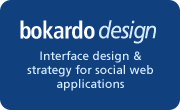January 30th
Intro to Social Design Podcast
For those of you who listen to podcasts and are interested in social design, here’s an option: Alex Barnett and Ted Haeger (the Bungee Connect folks) recently interviewed me about my take on social design. Long-time Bokardoans might remember me doing a series of podcasts a couple years ago with Alex, who was at Microsoft at the time. I’m happy to say that he’s now even more into podcasting. He always was a great host…ready at a moment’s notice with an insightful question.
Here’s the show post.
Here’s the RSS Feed (love the name of it) The Bungee Line.
Here’s the mp3: Social Design Interview (47min, 22MB)
The interview was part of a series that Ted and Alex are doing for Bungee Labs. They’re stretching out the role of the new community manager, who serves to not only help out with the community but also helps to lead the discussion in and around it. I think this will become a common model going forward.
Anyway, I’m honored to be part of their series…
Continue Reading: Intro to Social Design Podcast


